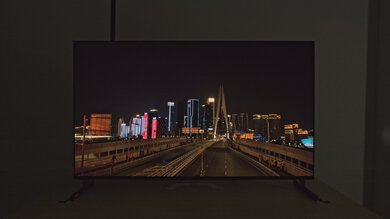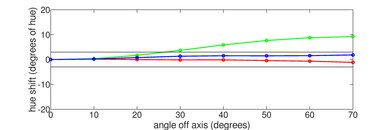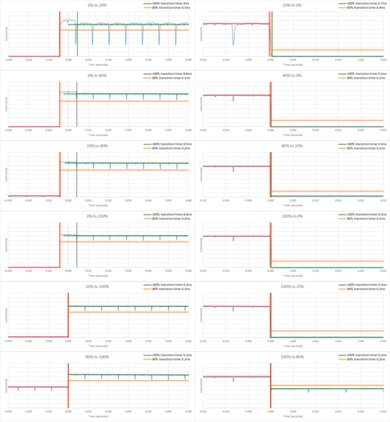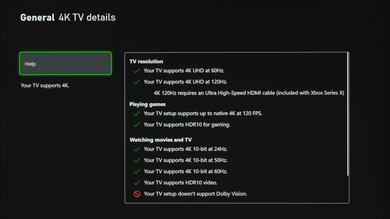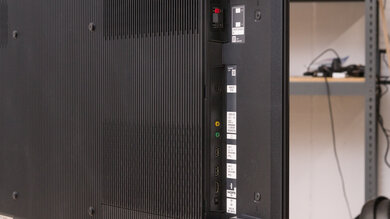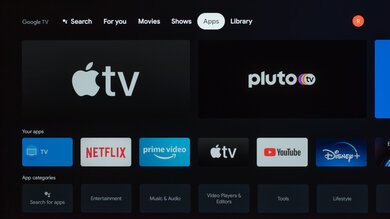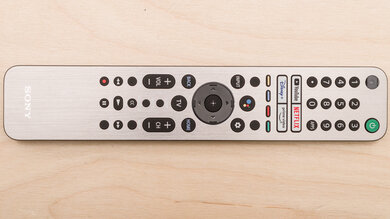The Sony A90J OLED is a premium 4k TV from Sony's 2021 flagship OLED lineup and sits above the Sony A80J OLED. Like other OLEDs, it delivers unparalleled picture quality thanks to its self-emitting pixels, which produce perfect blacks and a near-infinite contrast ratio. While its HDR brightness is only decent relative to LED TVs, it still delivers a great HDR experience thanks to its wide color gamut and high contrast ratio. It also has a near-instantaneous response time for clear motion, and it supports variable refresh rate (VRR) technology to reduce screen tearing, but it doesn't support FreeSync. On the upside, it has two HDMI 2.1 ports, eARC, and Dolby Vision support. Sony released the Sony A90K OLED in 2022, but it's not a direct replacement for the A90J as it's only available in 42 and 48-inch sizes.
Our Verdict
The Sony A90J is an amazing TV for mixed usage. It delivers exceptional picture quality for movies and TV shows, and its near-instantaneous response time results in smooth motion for sports and video games. While it doesn't get as bright as an LED TV, it's bright enough to bring out most highlights in HDR, aided by its near-infinite contrast ratio. Unfortunately, there's a risk of permanent burn-in, though it isn't an issue if you watch varied content.
- Near-perfect black levels.
- Exceptionally wide viewing angle.
- Motion looks exceptionally smooth.
- Risk of permanent burn-in.
- May not be bright enough in SDR for some.
The Sony A90J is great for watching TV shows. It has adequate SDR peak brightness and fantastic reflection handling, so glare from bright lights or windows isn't an issue. The Google TV platform is smooth and lets you access all your apps and shows from one smart hub. It has a very wide viewing angle, which is great for a wide seating arrangement.
- Fantastic reflection handling.
- Exceptionally wide viewing angle.
- Google TV platform is smooth and easy to use.
- May not be bright enough in SDR for some.
The Sony A90J is excellent for watching sports. Its near-instant response time results in smooth motion with almost no blur behind fast-moving objects or players. It also has a very wide viewing angle, which is great for watching the game with friends in a wide seating arrangement. It has adequate SDR peak brightness with fantastic reflection handling, so glare from bright lights or windows isn't an issue.
- Fantastic reflection handling.
- Exceptionally wide viewing angle.
- Motion looks exceptionally smooth.
- May not be bright enough in SDR for some.
The Sony A90J is fantastic for playing video games. It has a near-instantaneous response time that results in exceptionally clear motion with almost no blur behind fast-moving objects. Its input lag is slightly higher than on competing TVs, but it's still fantastic, so your inputs are responsive. The TV's exceptionally high contrast ratio is great for gaming in the dark, and the TV's adequate SDR peak brightness and fantastic reflection handling make it a good fit for bright rooms, too. Finally, it has great gaming features like HDMI 2.1 bandwidth and VRR support.
- Near-perfect black levels.
- Motion looks exceptionally smooth.
- Low input lag.
- VRR and ALLM support after firmware update.
- No FreeSync support.
- May not be bright enough in SDR for some.
The Sony A90J is excellent for watching movies in HDR. It has a wide color gamut, good HDR peak brightness, and a nearly infinite contrast ratio, so bright highlights look amazing in a dark or moderately lit room. The TV has fantastic image processing, so movies look their best no matter if they're from streaming platforms or physical media. Finally, its color accuracy is excellent without needing to be calibrated.
- Near-perfect black levels.
- Removes 24p judder.
- Upscales low resolution content without issue.
- Wide HDR color gamut.
- Good HDR peak brightness.
- Noticeable stutter with low frame rate content.
The Sony A90J is fantastic for HDR gaming thanks to its extremely fast response time and fantastic input lag. The TV has perfect black levels, and while it doesn't get as bright in HDR when in Game Mode as most LED TVs do, its brightness is still very decent, and it does make bright highlights pop in a dark or moderately-lit room. The TV is also very colorful thanks to its wide color gamut. It has great gaming features like HDMI 2.1 bandwidth and VRR support.
- Near-perfect black levels.
- Motion looks exceptionally smooth.
- Low input lag.
- Wide HDR color gamut.
- VRR and ALLM support after firmware update.
- No FreeSync support.
- Lower HDR peak brightness in Game Mode.
The Sony A90J is an excellent TV to use as a PC monitor. It has a fantastic input lag and near-instant response time, so your mouse inputs are extremely responsive. It can also display proper chroma 4:4:4 at most resolutions, and its wide viewing angle ensures the image stays consistent when you're sitting up close. Unfortunately, it doesn't support 1440p. There may also be more risk of permanent burn-in with static elements like a desktop user interface.
- Exceptionally wide viewing angle.
- Low input lag.
- Displays proper chroma 4:4:4.
- Near-instantaneous response time.
- VRR and ALLM support after firmware update.
- Risk of permanent burn-in.
- No FreeSync support.
- Doesn't support 1440p.
- May not be bright enough in SDR for some.
Changelog
- Updated Sep 26, 2025: We uploaded the latest brightness measurements and uniformity photos for the Accelerated Longevity Test.
- Updated Jul 08, 2025: We uploaded the latest brightness measurements and uniformity photos for the Accelerated Longevity Test.
- Updated Apr 17, 2025: We uploaded the latest brightness measurements and uniformity photos for the Accelerated Longevity Test.
- Updated Feb 11, 2025: We uploaded the latest brightness measurements and uniformity photos for the Accelerated Longevity Test.
Check Price
Differences Between Sizes And Variants
We tested the 55-inch Sony A90J OLED (XR-55A90J), which is also available in 65-inch (XR-65A90J) and 83-inch (XR-83A90J) sizes. The results are also valid for those models. The model codes are the same in Europe and the UK.
| Size | US Model |
|---|---|
| 55" | Sony XR-55A90J |
| 65" | Sony XR-65A90J |
| 83" | Sony XR-83A90J |
Our unit was manufactured in February 2021, and you can see the label here.
Popular TV Comparisons
The Sony A90J OLED is an amazing overall TV. It has good HDR peak brightness, fantastic image processing, and is very well-built. That said, it also comes with a very premium price tag, and while it has gaming features like HDMI 2.1 bandwidth and VRR support, other OLEDs are better for gaming, like the LG C1 OLED, which has FreeSync support and lower input lag.
For more options, see our recommendations for the best OLED TVs, the best 55-inch TVs, and the best TVs on the market.
The Sony A90J OLED and Sony A80L/A80CL OLED are extremely similar, with almost nothing to differentiate them. The biggest difference is the A90J's better pre-calibration accuracy, but it's close and could be due to panel variance. Otherwise, the A90J is a bit brighter in HDR, while the A90L is a bit brighter in SDR, but you won't notice it in practice.
The Sony A90J OLED is a bit better than the Sony A90K OLED, but the differences are very minor. The A90J is a bit brighter than the new model, meaning it can handle a bit more glare, and bright highlights in HDR stand out a bit more. Although sharing a similar model name, the A90K isn't a direct replacement for the A90J, as they're available in different sizes. The A90J is available in a 55", 65", and 83" size, while the A90K is only available in 42" and 48" sizes.
The Sony A80J OLED and the Sony A90J OLED are very similar TVs overall, and both offer stunning picture quality in a premium, well-built package. That said, the A90J uses Sony's new heatsink technology, which allows it to get brighter in HDR, although the difference is relatively small. The A90J also has a better remote with motion-activated backlighting. The other big difference is that the A90J is available in 55, 65, and 83 inch sizes, while the A80J is available in 55, 65, and 77 inch sizes. If none of these are dealbreakers, the A80J is still an excellent choice that performs about the same as its more expensive sibling.
The Sony A95K OLED is an improvement over the Sony A90J OLED, especially with watching HDR content. The A95K uses new QD-OLED technology, which is a type of OLED that allows it to display more vivid colors and brighter highlights than the A90J. However, if you want to use your TV in a well-lit room, the A90J maintains perfect black levels in well-lit rooms, as the black levels raise on the A95K when there's ambient lighting.

We buy and test dozens of TVs yearly, taking an objective, data-driven approach to deliver results you can trust. Our testing process is complex, with hundreds of individual tests that take over a week to complete. Most of our tests are done with specially designed test patterns that mimic real content, but we also use the same sources you have at home to ensure our results match the real-world experience. We use two main tools for our testing: a Colorimetry Research CR-100 colorimeter and a CR-250 spectroradiometer.
Test Results

Update 10/16/2023: After seeing its brightness surprisingly increase after eight months, the TV's brightness has come back down to expected levels. Again, we're not sure why the TV's brightness is fluctuating so much.
The stand can be set up in one of two ways, either with the feet flat, bringing the TV flush against the table, or raised up to give you space for a soundbar. There's also a third configuration where the feet face inward to make a smaller footprint, but it's only available on the 83-inch variant.
Footprint of the stand: 51.1"x12.5" (standard position) or 45.3"x12.5" (soundbar position)
The Sony A90J doesn't have much in the way of cable management except for some paneling that covers a portion of the cables and an included cable tie, but overall it looks fairly clean. The back of the panel itself is metal, while the rest is plastic with vertical ridges. Some of the inputs are bottom-facing and are hard to reach when the TV is wall-mounted.
The panel doesn't have a backlight, but thanks to its nearly infinite contrast ratio, it has the equivalent of a perfect local dimming feature with no zone transitions. We still film the zone transition video on the TV so you can see how the screen performs and compare it with a TV that has local dimming.
The Sony A90J has good HDR brightness, good enough to make bright highlights pop. However, there isn't much consistency across scenes with different luminance levels due to the TV's Automatic Brightness Limiter (ABL). It performs similarly to the LG G1 OLED, but it's not as bright as the LG G2 OLED. Warming up the TV doesn't significantly impact the HDR brightness.
These measurements are before calibrating the HDR white point with the following settings:
- Picture Mode: Custom
- Brightness: Max
- Contrast: 90
- Color Temperature: Expert 1
- HDR Tone Mapping: Gradation Preferred
We also measured the brightness in the 'Vivid' Picture Mode. It reached 777 nits in the Real Scene Highlight and 976 nits in the 10% window.
In 2021, there’s a new settings menu called HDR Tone Mapping. Our measurements use the 'Gradation Preferred' setting, but it may be helpful to note that while the 'Gradation Preferred' setting results in a more accurate EOTF, the 'Brightness Preferred' setting lets you get a brighter image without having to make too many other adjustments. If you want to see the difference these settings make, you can see the 'Brightness Preferred' EOTF here and the EOTF with HDR Tone Mapping disabled here.
To make HDR brighter, set Advanced Contrast Enhancer to 'High', Peak Brightness to 'High', set Brightness, Contrast, and Gamma to max, and 'Brightness Preferred' in the HDR Tone Mapping menu. These settings result in this EOTF. We should also note that we were able to adjust the settings to achieve a peak HDR brightness measurement of 1291 nits in the 2% window, which is close to the 1300 nits that early reviews claimed. However, the screen got very hot and quickly dropped back down to a lower luminance level, so while the TV is technically capable of hitting an exceptionally high peak brightness for an OLED, realistically speaking, you won’t get that kind of brightness with real content using ideal settings.
The HDR brightness in 'Game' mode is very similar to the HDR brightness outside of ‘Game’ mode. That said, the brightness measured slightly lower than outside of 'Game' mode, especially the real scene brightness. As with SDR, you can set HDR Tone Mapping to 'Brightness Preferred' to get a slightly brighter image, though we expect that this will depend highly on the content. Warming up the TV makes certain Real Scenes brighter, but doesn't change much overall.
These measurements are before calibrating the HDR white point with the following settings:
- Picture Mode: Game
- Brightness: Max
- Contrast: 90
- Color Temperature: Expert 1
- HDR Tone Mapping: Gradation Preferred
These are measurements in the 'Game' Picture Mode with the Brightness Preferred setting enabled:
- Real Scene Highlight: 667 cd/m²
- Peak 2% Window: 804 cd/m²
- Peak 10% Window: 769 cd/m²
- Peak 25% Window: 511 cd/m²
- Peak 50% Window: 293 cd/m²
- Peak 100% Window: 193 cd/m²
- Sustained 2% Window: 763 cd/m²
- Sustained 10% Window: 723 cd/m²
- Sustained 25% Window: 499 cd/m²
- Sustained 50% Window: 293 cd/m²
- Sustained 100% Window: 192 cd/m²
The TV has superb PQ EOTF tracking, so content is displayed at the correct brightness level. It's slightly over-brightened at all luminance levels but barely so, and it never strays far from what it should be. The TV follows the curve nearly perfectly up until the panel's max brightness, followed by a slow roll-off which preserves bright details.
The Sony A90J has okay SDR brightness. It’s a bit dim in real scenes compared to an LED TV, and the Automatic Brightness Limiter (ABL) causes scenes with large areas of brightness to dim overall, so the brightness isn’t the most consistent across different scenes. It's a bit brighter than the new, smaller sizes of the Sony A90K OLED. Warming up the TV has no significant impact on its SDR brightness. If you want a high-end TV that gets much brighter, check out the Samsung QN900A 8k QLED.
These measurements are after calibration with the following settings:
- Picture Mode: Custom
- Brightness: Max
- Peak Luminance: High
- Color Temperature: Expert 1
We checked the brightness with other Picture Modes. 'Cinema' isn't as bright as 'Custom' because it has a Real Scene Peak Brightness of 248 nits. 'Vivid' is also still brighter as we measured a peak of 780 nits in the 10% window.
The color volume is decent. It only really struggles a bit with very bright colors, which aren't as bright as on QD-OLED displays like the Samsung S95B OLED.
The Sony A90J has amazing pre-calibration color accuracy. Colors and white balance are both excellent, with few inaccuracies. The color temperature is quite close to our 6500K target, but it's on the cooler side. Lastly, gamma follows the target very well, with only the brightest scenes appearing a bit brighter than they should.
After calibration, the Sony A90J has exceptional color accuracy. Any remaining inaccuracies aren't noticeable, and the TV's color temperature is very close to the target value. Gamma is practically perfect. The TV was also very easy to calibrate. You can download the Calman for Bravia app to access 20-point calibration and Custom Pro, but you also need a 2018 version of Calman or newer on your PC to access calibration. You can see our full calibration settings here.
The Sony A90J has excellent gray uniformity. The screen looks very uniform overall with almost no dirty screen effect, and we didn't notice any banding or issues in near-dark scenes, although this can occur with more extensive use.
Note: A few owners have reported seeing a grid-like pattern on their TVs in uniform scenes. It's usually not noticeable with real content, but this is a manufacturing defect; if you see it on yours, you should exchange it.
The Sony A90J has an excellent viewing angle, but it's not quite as good as the LG A1 OLED. It's wide enough that the image won't look washed except at extreme angles, where the TV is considerably dimmer.
The Sony A90J has great gradient handling in HDR, with only bright greens having noticeable banding.
The Sony A90J uses a WRGB sub-pixel layout, where all four subpixels are never lit simultaneously. While this TV is said to be able to brighten all four pixels at once to achieve a higher peak brightness, we never saw all four sub-pixels lit at the same time, even when we recorded 1291 nits. You can see some of the blue sub-pixels lit up in this photo.
The TV has an optional black frame insertion feature (BFI) that reduces the appearance of persistence blur caused by the TV's nearly instantaneous pixel response time. BFI also reduces the TV's perceived brightness, which is noticeable.
The TV can interpolate lower frame rate content up to 120fps to make motion look smoother, which is also known as the 'Soap Opera Effect'. It performs fine during slower scenes, but there's a fair number of artifacts in busier scenes or panning shots.
Due to the TV's nearly instantaneous response time, there's noticeable stutter with low frame rate content. The black frame insertion feature and the motion interpolation feature can help reduce the appearance of stutter, but they both have their drawbacks.
Unlike the LG A1 OLED, the Sony A90J TV can remove judder from all sources. You don't need to enable any additional settings for native 24p content. For 24p content via 60p/i or via native apps, set Cinemotion to 'High' and Motionflow to 'Custom' but leave the sliders at 0.
The TV has HDMI Forum VRR support with firmware v6.4048, and it works without any issue on the Xbox Series X for a tear-free gaming experience. However, it doesn't support FreeSync. It's also G-SYNC compatible, but there are some issues with it. It removes tearing with 4k @ 120Hz signals from the NVIDIA RTX 3060 graphics card, but at first, the screen flickered until the TV and PC were both reset. Still, there wasn't any screen tearing or flicker in Destiny 2 with a 4k @ 120H signal. Despite there being a few issues depending on the signal, VRR reduces screen tearing when it works properly.
The TV has a low input lag, although it's slightly higher than competing high-end models and rises significantly outside of 'Game' mode. To get low latency, you can use either the 'Game' or 'Graphics' Picture Mode, though we recommend 'Game' mode to get the lowest latency for gaming.
The TV supports most common resolutions up to 4k @ 120Hz. However, the TV doesn't support 1440p; it upscales 1440p signals to 4k or shows a black screen when trying to force a 1440p signal.
The Sony A90J is not fully compatible with the PS5 due to not supporting 1440p. Still, as part of Sony's 'Perfect for PS5' lineup, it supports a few unique features when paired with a PS5, including Auto HDR Tone Mapping and Auto Genre Picture Mode. After a firmware update to version PKG6.5660.0668NAA, the Sony Bravia XR A90J also now supports both VRR and ALLM.
We received comments suggesting that the A90J has more banding issues in HDR at 4k @ 120Hz than in SDR. We retested the TV to check for this. With Destiny 2 on the Xbox Series X, there was slightly more banding in HDR in parts of the sky or the main menu, but you'd have to look for it to notice. On the PS5, we tested with Call of Duty: Cold War, and the visibility of banding is highly dependent on the map. With some maps, there was noticeable banding in both SDR and HDR, although it was worse in HDR. In others, the banding was more minimal and only noticeable in clouds in HDR. With Destiny 2 on the RTX 3070, however, we didn't notice an appreciable difference between SDR and HDR regarding banding. It leads us to believe that while there is more banding in HDR than in SDR at 4k @ 120Hz, it's highly dependent on the content.
The Sony A90J can nearly take full advantage of the Xbox Series S|X consoles. It only supports Dolby Vision gaming at 60Hz, not at 120Hz, though, and the TV doesn't support 1440p. After a firmware update to version PKG6.5660.0668NAA, the TV now supports both VRR and ALLM.
We received comments suggesting that the A90J has more banding issues in HDR at 4k @ 120Hz than in SDR. We retested the TV to check for this. With Destiny 2 on the Xbox Series X, there was slightly more banding in HDR in parts of the sky or the main menu, but you'd have to look for it to notice. On the PS5, we tested with Call of Duty: Cold War, and the visibility of banding is highly dependent on the map. With some maps, there was noticeable banding in both SDR and HDR, although it was worse in HDR. In others, the banding was more minimal and only noticeable in clouds in HDR. With Destiny 2 on the RTX 3070, however, we didn't notice an appreciable difference between SDR and HDR regarding banding. It leads us to believe that while there is more banding in HDR than in SDR at 4k @ 120Hz, it's highly dependent on the content.
HDMI ports 3 and 4 support the full 48 Gbps bandwidth of HDMI 2.1, while HDMI 1 and 2 are limited to HDMI 2.0 bandwidth. However, because HDMI 3 is also the eARC port, you lose an HDMI 2.1 slot if you connect a receiver, so you can't use HDMI 2.1 bandwidth on multiple devices simultaneously.
The Sony XR55A90J supports eARC, allowing you to pass high-quality, uncompressed audio to a compatible receiver through an HDMI cable. It supports all major audio formats, so you don't have to worry about compatibility with external sources.
The TV has a decent frequency response. It has more bass than most TVs but is still very muted. While dialogue sounds okay overall, and the TV gets very loud, there's a lot of compression at higher volumes, resulting in pumping artifacts.
Distortion performance is decent. There isn't much distortion at most volume levels, but it gets quite distorted at max volume.
The Google Play Store has tons of apps available to download, and they run very smoothly. It has Google Chromecast built-in, meaning you can cast content from your phone.
The Sony Bravia A90J has a similar remote to other Sony OLEDs, like the Sony A9S OLED. It has shortcut buttons to the most popular streaming apps and a dedicated Google Assistant button that activates its voice command feature. You can use voice commands to change inputs, adjust certain settings, search within apps, and more. It can also be used as a universal remote, although it may depend on your country and particular device. The remote also has new, motion-activated backlighting, so you can see the buttons in the dark. We also tested the TV to check if it still works with the Android TV app, even though it now has Google TV. It works perfectly, and you get the same features as you did with Android TV, like voice control.












